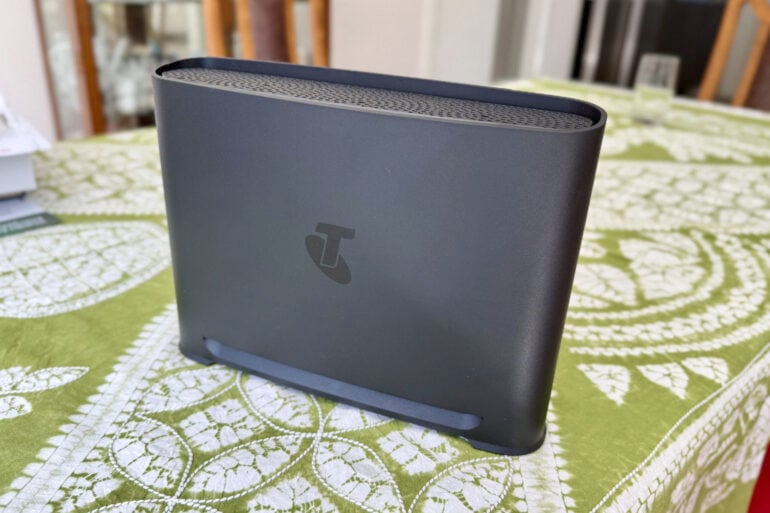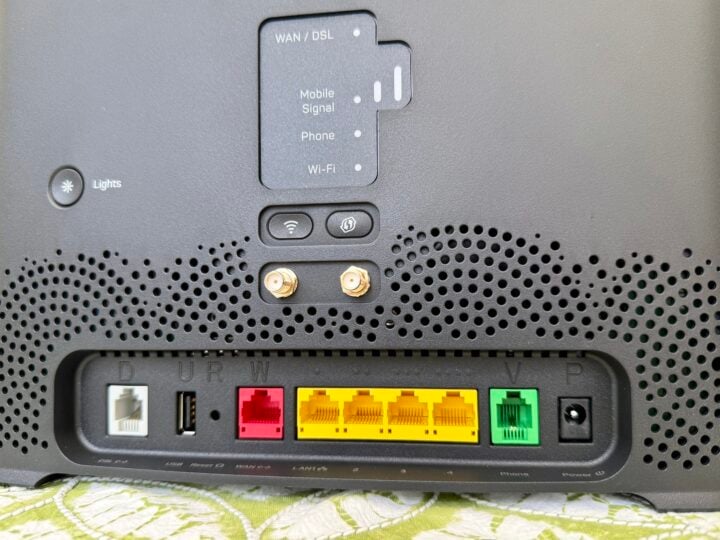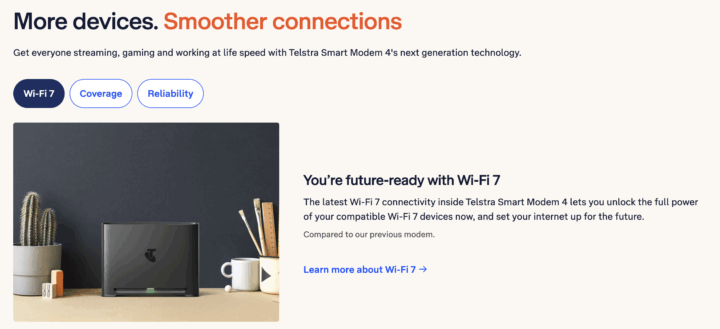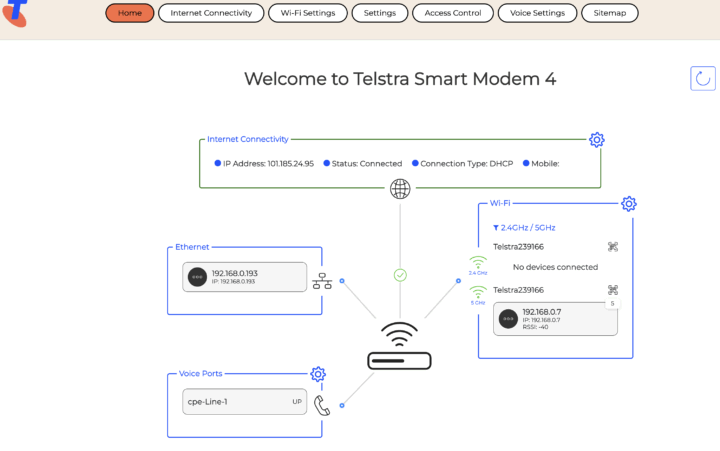
As the NBN gets faster, the Telstra Smart Modem Gen 4 offers Wi-Fi 7 for flinging high-speed broadband around your home – but there’s a big catch.
The recent NBN speed boost offered a major shot in the arm to Aussie homes on 100+ Mbps plans via FTTP and HFC – with 100/20, 250/25 and 1000/50 plans leaping to 500/50, 750/50 and 1000/100 respectively.
Keep in mind, you might miss out on the automatic speed boost if, like me, you’re on a less popular plan like FastPlus 100/40. I had to call Aussie Broadband and ask them to switch me across to one of the new, faster plans – jumping up to 500/50 while actually saving a few bucks.
Once that speed boost reaches your home, it might become clear that your home Wi-Fi network is no longer doing your broadband connection justice. So it’s probably not a coincidence that the Wi-Fi 7-capable Telstra Smart Modem Gen 4 has arrived, available exclusively to Telstra customers as an upgrade to the old Telstra Smart Modem Gen 3.
Be warned, looking at the spec sheet, the Telstra Smart Modem Gen 4 barely scrapes in as a Wi-Fi 7 modem. It’s going to disappoint people who want to make the most of Wi-Fi 7, although admittedly, Telstra’s target market has never been power users.
Table of contents
- First impressions
- Specifications and price
- Features
- Quality
- Who is the Telstra Smart Modem Gen 4 for?
Telstra Smart Modem Gen 4 first impressions
The Telstra Smart Modem Gen 4 has a much larger footprint than its predecessors; it’s almost twice as wide. This might make it difficult to do a straight swap if you’ve crammed a Gen 3 or Gen 2 smart modem into a small space.
The good news is that it’s simple to make the changeover, as the Gen 4 features colour-coded rear sockets and simple instructions for plugging everything in.
Remember, Telstra Smart Modems only work with a Telstra NBN connection. Like I said, I’m with Aussie Broadband, so I tested it at my mother-in-law’s house. Upgrading from her Gen 2 modem was easy, simply a matter of unplugging all the cables from the back and plugging them into the corresponding sockets on the Gen 4.
On the back of the Gen 4, you’ve got a white DSL socket and a red Gigabit WAN socket for connecting to your NBN NTD box. Alongside this are four yellow Gigabit LAN ports for connecting wired devices, and a green phone port for your Telstra home phone.
Side note: Telstra and Optus customers (I’m not sure about Vodafone) who want to keep using their home phone service must use a modem/router provided by their telco. Some other telcos will happily share your home phone connection settings, so you can set up your home phone using a third-party modem/router or a dedicated Analog Telephone Adapter (ATA) box like the Cisco SPA112.
On the back of the Gen 4, you’ll also find a USB 2.0 port and WPS button for easily connecting Wi-Fi devices. If you’re upgrading, the Gen 4 will have a different Wi-Fi network name and password from your existing Telstra modem.

Like the Gen 3 before it, the Telstra Smart Modem Gen 4’s big selling point is mobile fallback in case your home broadband service is disrupted. The Gen 4 supports both 4G and 5G, with the option to attach external antennas on the back to boost your indoor reception.
Stepping up from 4G to 5G fallback sounds promising, but keep in mind it’s capped at 25/5 – enough to keep you online, but not in style. Throttling it to 25/5 also reduces the load on the Telstra mobile network if your suburb goes offline and all the Telstra NBN customers fall back to mobile broadband simultaneously.
It’s worth mentioning that Optus and Vodafone also offer mobile fallback to fixed-line broadband customers. If you’re not with one of the big three telcos, you’ll find a range of other wireless modem routers that support mobile fallback to your mobile network of choice via a USB dongle.
Telstra Smart Modem Gen 4 specifications and price
| Wi-Fi | WiFi 7 802.11be |
| Fallback | 5G / 4G mobile broadband |
| Wi-Fi Bands | Dual band 2.4 GHz (4×4) / 5 GHz (4×4) |
| Ports | Gigabit WAN x1 DSL x1 Gigabit LAN x4 Phone x1 USB2.0 x1 |
| Wireless security | WPA2/WPA3 |
| Hardware | Quad-core ARM Cortex-A55, 2.2GHz 2GB LPDDR4 RAM 8GB eMMC flash storage |
| Dimensions | 260 x 65 x 195 mm |
| Weight | 990 g |
| Price | Free for new Telstra customers on 24-month plan, $10 p/m for 24 months for existing customers |
| Warranty | 2 years |
| Official website | Telstra |
Features
The biggest improvement with the Telstra Smart Modem Gen 4 is the step up to Wi-Fi 7 802.11be. In theory, Wi-Fi 7 offers a range of benefits in terms of speed and performance, but don’t get too excited until you read the fine print.
The first catch is that Gen 4 only supports the 2.4 GHz and 5 GHz wireless bands, failing to add 6 GHz Wi-Fi to deliver faster speeds over shorter distances to compatible devices. To be fair, 6 GHz is not mandatory to earn the Wi-Fi 7 badge, but it’s a big part of Wi-Fi 7’s attraction.
You also miss out on 4096-QAM, or 4K-QAM, which lets Wi-Fi 7 squeeze through more data than Wi-Fi 6. Plus, you’re stuck with 1 gigabit Ethernet LAN and WAN ports, which can’t make the most of Wi-Fi 7’s potential speeds.
Despite these major shortcomings, Telstra still has the nerve to claim on its website that “the latest Wi-Fi 7 connectivity inside Telstra Smart Modem 4 lets you unlock the full power of your compatible Wi-Fi 7 devices now, and set your internet up for the future”.

No, it absolutely does not unlock “the full power of Wi-Fi 7 devices” which support 6 GHz, 4K-QAM and at least 80 MHz wide channels, which is most of them. Perhaps that’s why Telstra declines to cite the modem’s potential Wi-Fi speeds on the device’s specs page.
Thankfully, the Telstra Smart Modem Gen 4 does support Wi-Fi 7’s Multi-Link Operation (MLO). This means that some Wi-Fi 7-compatible devices can connect to the 2.4 and 5 GHz bands simultaneously for a speed boost.
That’s good news, because Telstra’s smart modem only supports 20 and 40 MHz wide wireless channels, even though the Wi-Fi 7 standard supports up to 320 MHz wide channels for squeezing through a lot more data. So if you’re taking advantage of MLO, your Wi-Fi 7 devices can combine a 2.4 GHz 40 MHz connection and a 5 GHz 40 MHz connection.

Like Telstra’s old Gen 3 smart modem, the Gen 4 also supports bandsteering to automatically shift your devices between the 2.4 and 5 GHz bands to get the best performance. As you walk away from the modem toward the other end of the house, your devices might switch from fast 5 GHz to more reliable 2.4 GHz, then back again as you move closer to the modem.
If you still have wireless black spots in your home, the Telstra Smart Modem Gen 4 works with a Telstra Smart Wi-Fi Internet Booster.
Quality
If you’ve got MLO-capable Wi-Fi 7 devices at hand, the Telstra Smart Modem Gen 4 does manage to offer a speed boost over Wi-Fi 6 if you’re up close.
To put the Gen 4 to the test, I turned to a desktop Gigabyte MBG-GC-WIFI7 PCIe wireless adapter installed in a Windows 11 box. The Gigabyte adapter supports 320 MHz channels across the 2.4, 5 and 6 GHz bands, as well as MLO for connecting bands.
At a range of three metres, the Gigabyte Wi-Fi 7 adapter hit 880 Mbps while transferring a 2.5 GB disc ISO. It was coming via FTP from my MacBook Pro, attached to one of the Telstra modem’s Ethernet LAN ports using a USB-C to 2.5 Gbps Ethernet adapter. This was taking advantage of MLO to connect on 2.4 and 5 GHz simultaneously, but only using a 40 Hz channel on each band.
Dipping into the settings to switch the Telstra Smart Modem Gen 4 from Wi-Fi 7 to Wi-Fi 6, it only offered 800 Mbps on 5 GHz alone. That seems like an impressive 10 per cent boost from Wi-Fi 7, but it’s not the whole story.
From previous testing of Wi-Fi 7 and 6E routers like the Netgear Orbi 970, Asus RT-BE92U and Asus RT-AXE7800, I know that the 880 Mbps mark can be the real-world speed limit of gigabit Ethernet. At this point, with other routers, I would switch to their 2.5 or 10 Gbps Ethernet LAN ports, so I could watch Wi-Fi 7 smash the gigabit barrier.
Frustratingly, unlike most Wi-Fi 7 routers, the Telstra Smart Modem Gen 4 doesn’t feature multi-Gigabit Ethernet LAN and WAN ports – you’re stuck with 1 Gbps. This means you can’t make the most of Wi-Fi 7 speeds or make the most of home broadband services faster than 1 Gbps (which, to be fair, Telstra doesn’t seem to offer to residential customers).
In some homes, the biggest selling point for the Gen 4 would be the 4G / 5G fallback. It works as advertised when you yank out the cable from your NBN box, but it’s not a seamless transition – downloads, streaming and voice calls are all disrupted for around 30 seconds during the handover.
With the modem’s 5G signal showing 2 of 3 bars, it offered 18.5 Mbps down and 4.3 Mbps up. Remember, 5G signals can struggle to penetrate buildings, so if you were really struggling for coverage, you could add external antennas to the back of the modem.
When your fixed line service reconnects, you’ll automatically switch back from 5G, again taking about 30 seconds.
Who is the Telstra Smart Modem Gen 4 for?
If you’re feeling generous, you could say that, like most Telstra offerings, the Telstra Smart Modem Gen 4 is for people who like to keep things simple.
If you’re feeling more cynical, you could say that, like most Telstra offerings, the Telstra Smart Modem Gen 4 is for people who don’t know they can do better elsewhere.
It’s hard to excuse deliberately misleading customers by implying they’re getting “the best of Wi-Fi 7” when the Telstra Smart Modem Gen 4 lacks 6 GHz, 4K-QAM support and wider than 40 MHz channels, not to mention Ethernet ports which can actually break the 1 Gbps barrier.
If your needs are simple and you’d make the most of 5G fallback, perhaps you’d be happy with Telstra’s sorry excuse for a Wi-Fi 7 “smart” modem.
The post Telstra Smart Modem Gen 4 review: Wi-Fi 7-lite appeared first on GadgetGuy.



0 (mga) komento:
Mag-post ng isang Komento